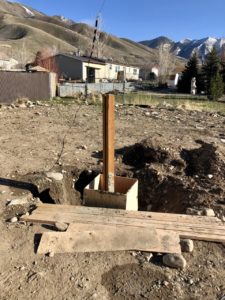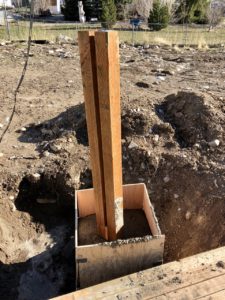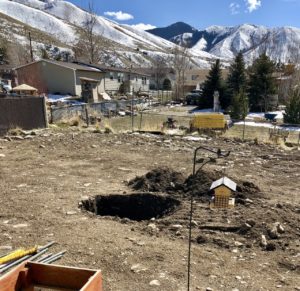After almost three weeks of rain, snow, freezing temperatures, more rain, and more snow, a couple of days ago spring broke through. The ground has dried out, the snow on the local mountains has disappeared, and everything was ready to move to the next step with the antenna mast I’m putting up in the back yard.
I ran across a “handyman” by the name of Jimmy who was willing to come over and help me get the foundation dug and the cement poured. Yesterday I picked up 21 eighty-pound bags of Sakrete from Home Depot. reserved a cement mixer for today, and got all the tools in readiness. Jimmy arrived a little past noon and we got underway.

When the hole was the right depth we built the cement forms to provide for two feet of concrete with the 4×4 posts in the center. Then we fired up the cement mixer and proceeded to mix twenty-one bags of concrete and pour that into the box.
Three hours later, 2,500 pounds of concrete were in the box ready to cure. I’m pretty sure the wind won’t blow this over!
Jimmy will come back on Monday when we’ll take the forms apart and fill up the hole.

Between the two posts is where the 3/4″ galvanized steel pipes will sit. Bolts through the posts and the pipe will secure the mast to the posts. The top bolt, which will be about six inches below the top will serve as a pivot point. Two more bolts will secure the pipe.
The concrete comes up to about three inches below ground level so it can be covered with dirt and grass planted around.
One last item to stick in before we fill in the hole is a copper grounding rod. The galvanized pipe will be secured with a copper strap to the grounding rod. We don’t get much lightning around here, but it’s still a very good practice to ground the pipe!
So, Monday the hole will get filled in and I can start on the mast. I won’t need Jimmy’s help with that.
As described in an earlier post, the mast will be thirty-five feet high with a pulley afixed (about six inches from the pipe) to haul up (or down) the G5RV antenna. The window line will come straight down and mounted (with a six-inch standoff) to the 4×4 posts. I’m also going to put a two-meter J-pole antenna at the top of the mast and use that for an AllstarLink node I want to put up here in Tooele. So I’ll be running two coax cables out to the mast. One will be LMR-400 which will connect to the G5RV and the other RG-213 that’ll connect to the J-pole. I’ll run a messenger line from the edge of my roof out (about twenty feet off the ground) to the mast with carabiners every foot or so and the coax will ride in the carabiners. The coax then goes down a pipe up on the roof that I had installed when we built the house and into my shack.
When this is finished in the next couple of weeks, I’ll have the full-sized G5RV running roughly north-north-west to south-south-east diagonally across the back yard. The 2-meter J-pole will be atop the center mast holding up the G5RV.
Across the peak of the roof is a G5RVjr which barely fits on the roof. To the side of the house up about 20 feet are some military poles on which a 2-meter/70cm J-pole is mounted along with a twenty-meter ham-stick dipole. That antenna is oriented north and south to fill in the gap from the G5RVjr across the roof of the house, running east and west.
That will be 5 antennas. Enough for now. I’ll have coverage on 80-meters through 70cm across these antennas. Should be enough for a while.
